
Solapur is a city located in the south-western region of the Indian state of Maharashtra, close to its border with Karnataka. Solapur is located on major Highway, rail routes between Mumbai, Pune, Bangalore and Hyderabad, with a branch line to the cities of Bijapur and Gadag in the neighbouring state of Karnataka.Solapur international Airport is under construction. It is classified as A1 Tier and B-1 class city by House Rent Allowance (HRA) classification by the Government of India. It is the 5th biggest city in Maharashtra and the 49th most populous city in India and 43rd largest urban agglomeration.
The Indian Patent Office is administered by the Office of the Controller General of Patents, Designs & Trade Marks (CGPDTM). This is a subordinate office of the Government of India and administers the Indian law of Patents, Designs and Trade Marks.
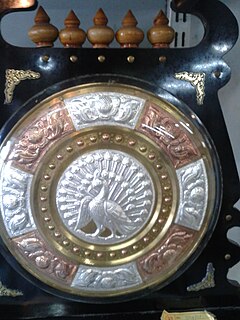
The Thanjavur Art Plate is an artifact which is exclusively made in Thanjavur, Tamil Nadu, India. It is a circular plate made as a gift item. It is a handicraft consisting of metals such as silver, bronze, and copper embossed with figures of gods and goddesses at its center. The artwork has been registered for protection under the Geographical indication of the Trade Related Intellectual Property Rights (TRIPS) agreement. It is listed at item 63 as "Thanjavur Art Plate" of the GI Act 1999 of the Government of India, with registration confirmed by the Controller General of Patents Designs and Trademarks. Only the size of the article is permitted to be different while other metal compositions and particularization have to remain the same as per GI approval.

Sankheda furniture is colourful teak wood furniture of Gujarat, India, treated with lacquer and painted in traditional bright shades of maroon and gold. It is made in Sankheda village and hence its name. The village is located about 45 kilometres (28 mi) from Vadodara.
Kamalapur Red Banana is a special variety of Red banana which is exclusively grown in the valley of Kamalapur village and its surrounding areas in Gulbarga district of Karnataka, India. It is known as a "rich man's fruit" as it is marketed at a higher price compared to other varieties of banana due to greater inputs in farming with fertilizer, water, and workforce. While its skin is red coloured, the pulp is creamish in colour with an enjoyable taste. It has a high calorie value with Vitamin C and B6, which makes it a health food.

Odisha Ikat is a kind of ikat, a resist dyeing technique, originating from Indian state of Odisha. Also known as "Bandha of Odisha", it is a geographically tagged product of Odisha since 2007. It is made through a process of tie-dying the warp and weft threads to create the design on the loom prior to weaving. It is unlike any other ikat woven in the rest of the country because of its design process, which has been called "poetry on the loom". This design is in vogue only at the western and eastern regions of Odisha; similar designs are produced by community groups called the Bhulia, Kostha Asani, and Patara. The fabric gives a striking curvilinear appearance. Saris made out of this fabric feature bands of brocade in the borders and also at the ends, called anchal or pallu. Its forms are purposefully feathered, giving the edges a "hazy and fragile" appearance. Ikat's equivalent usage in Malay language is mengikat, which means "to tie or to bind".
Navalgund Durries, geographically tagged in India, are woven durries or a type of Indian rug with geometric designs, birds, and animal designs from Navalgund in Dharwad district of Karnataka, India
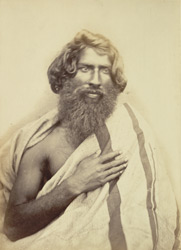
The Toda Embroidery, also locally known as "pukhoor", is an art work among the Toda pastoral people of Nilgiris, in Tamil Nadu, made exclusively by their women. The embroidery, which has a fine finish, appears like a woven cloth but is made with use of red and black threads with a white cotton cloth background. Both sides of the embroidered fabric are usable and the Toda people are proud of this heritage. Both men and women adorn themselves with the embroidered cloaks and shawls.
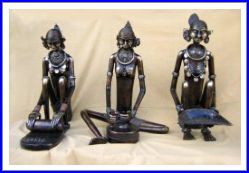
Bastar Wooden Crafts are traditional Indian wooden crafts that are manufactured in the Bastar district of Chhattisgarh state, India. The wood-crafting work has been protected under the Geographical indication (GI) of the Agreement on Trade-Related Aspects of Intellectual Property Rights (TRIPS) agreement. It is listed at item 84 as "Bastar Wooden Craft" of the GI Act 1999 of the Government of India with registration confirmed by the Controller General of Patents Designs and Trademarks.

Kannauj Perfume, also known as Kannauj Ittar, is a traditional Indian perfume manufacture. The perfume production is popular in Kannauj, in the Uttar Pradesh state, India.

Khurja pottery is traditional Indian pottery work manufactured in Khurja of the Bulandshahr district in Uttar Pradesh state, India. Khurja pottery has been protected under the Geographical indication (GI) of the Agreement on Trade-Related Aspects of Intellectual Property Rights (TRIPS) agreement. It is listed at item 178 as "Khurja Pottery" of the GI Act 1999 of the Government of India with registration confirmed by the Controller General of Patents Designs and Trademarks.
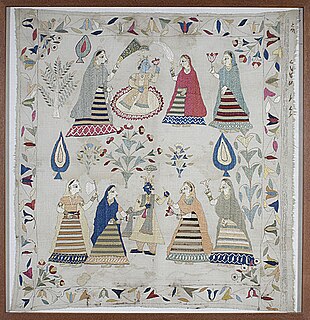
The Chamba Rumal or Chamba handkerchief is an embroidered handicraft that was once promoted under the patronage of the former rulers of Chamba kingdom. It is a common item of gift during marriages with detailed patterns in bright and pleasing colour schemes.

Santiniketan Leather Goods are leather products made in Santiniketan and surrounding villages near Kolkata, West Bengal, India. The material used is vegetable tanned leather with art work done by touch dyeing. Its artistic leather bags are popular in foreign markets and are exported to many countries including Japan and the U.S. They are generally made of E. I. Leather from sheepskin and goatskin.
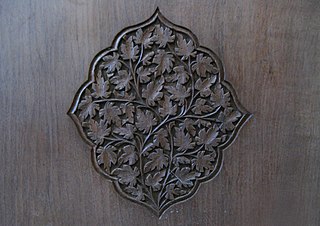
Kashmir Walnut Wood Carving is wood carving work that are manufactured in the Jammu & Kashmir state, India. The Walnut Wood Carving work has been protected under the Geographical indication (GI) of the Agreement on Trade-Related Aspects of Intellectual Property Rights (TRIPS) agreement. It is listed at item 182 as "Kashmir Walnut Wood Carving" of the GI Act 1999 of the Government of India with registration confirmed by the Controller General of Patents Designs and Trademarks.
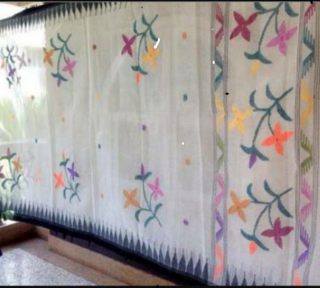
Wangkhei Phee is a textile fabric made of white cotton. It is a product which is protected under the GI registration and is made throughout the Indian state of Manipur and is woven by women. The fabric is transparent, has many designs on its body, and is popularly worn by women of Manipur for marriage ceremonies and other festive occasions.
Moirang Phee is a textile fabric which has a specific design called the "MoirangPheejin" which is woven sequentially on both longitudinal edges of the fabric and oriented towards the center of the cloth, with cotton or silk threads. It is a product which is protected under the GI registration and is made throughout the Indian state of Manipur. It was originally a product of Moirang village.
Shaphee Lanphee is a traditional textile fabric woven and embroidered, usually as a shawl, with embroidered motifs with cotton threads generally by Meitei women of Manipur. The fabric was, in the past, presented as a gift of honour to the soldiers for their bravery in a successful war, and to the praise-worthy chiefs of the Nagas of Manipur by the king of Manipur. It is a product which is protected under the GI registration and is now made throughout the Indian state of Manipur.
The Sujani embroidery work of Bihar, is a textile expressive art product, given protection under the GI registration act. It is usually a quilt or bed spread, which was earlier made of old clothes, but is now generally made of easily available fabric with embroidery done with the most simple stitches with motifs narrating stories. It is exclusively made by women in 15 villages of Bhusra in the Gaighat block of Muzaffarpur and a few villages of Madhubani in the Indian state of Bihar.
Madurai Sungudi is a cotton fabric of Madurai in the Indian state of Tamil Nadu, which is an exclusive textile product traditionally produced using tie and dye method by the Saurashtrians who migrated to Madurai under the patronage of King Thirumalai Naicker in the 17th century. The fabric's traditional popular use is as a saree; the fabric is now also used to make shirts, salwars, shawls, handbags, bed sheets and pillow cases. The product has been given protection under the GI registration act.
Bastar Iron Craft is a traditional Indian iron crafts that are manufactured in the Bastar district of Chhattisgarh state, India. The iron-crafting work has been protected under the geographical indication (GI) of the Agreement on Trade-Related Aspects of Intellectual Property Rights (TRIPS) agreement. It is listed at item 82 as "Bastar Iron Craft" of the GI Act 1999 of the Government of India with registration confirmed by the Controller General of Patents Designs and Trademarks.












